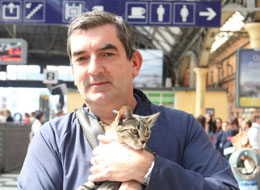Social Media: The Good, the Bad and the Ugly
By Jamie Galvin In Company News
With each passing day, social media becomes more institutionalized within our culture, and our ability to separate social media from ordinary life becomes opaque and jaded. Such a transformation – social media into the norm of everyday life – also encourages the public to use social media as a gateway for sharing of every kind of information without thinking twice.
Below you’ll find real-life examples of how society has embraced social media to portray the good, the bad and the ugly.
The Good
Twitter came to the rescue for a suburban house cat, Lilou, who wandered into an Ireland train station and boarded a railcar. The feline road into the bustling city of Dublin before she was discovered by the railway staff, which cared for the lost animal for the interim as they took immediate action to locate her owner.
The staff members then tweeted about the discovery of the cat on the company’s IrishRail account, including her origins– thanks to security camera footage – and a photo. The railway heroes hoped that the rightful owner would reply to their posting and, fortunately, that’s just what happened.
The Bad
In a recent survey of 100 college students (50 male and 50 female), York University psychologist Soraya Mehdizadeh tested a theory of self-esteem and narcissism among young adults that’s linked with the consumption of social media, specifically Facebook.
According to the study called “Self-Presentation 2.0: Narcissism and Self-Esteem on Facebook,” a typical narcissist views Facebook as a “gateway for hundreds of shallow relationships and emotionally detached communication.” Most notably, however, social networking, in general, grants users enormous control over how he/she is displayed to and perceived by peers and other users.

Overall, the survey showed that people who scored higher in terms of narcissism also spent more time on Facebook, checking it more times daily than their less narcissistic counterparts.
How many times have you logged on today?
The Ugly
A ruthless act of animal cruelty documented on YouTube has social media consumers in an uproar as they protest the inhumane acts carried out by two unknown villains. The crime: throwing puppies into a river.
In the horrific video footage, an unknown girl speaks Croatian in a cheerful tone to say, what’s translated as, “Can it swim?” The girl, who was allegedly filmed by her brother, is believed to be a resident of the city of Bugojno in Bosnia and Herzegovina based on other supporting evidence of the video.
The videographer uploaded the footage to YouTube, yet removed it shortly after. Then, claiming to be the girl’s brother the alleged cameraman entered a Croatian gaming site to seek help; however, the focus was quickly switched to his recent and heinous act upon self-identification. He rebutted with an argument that claimed the puppies were stray and that they had to do it to “protect their health.”
We can only respond with the hope that karma finds both guilty parties.




No Comment